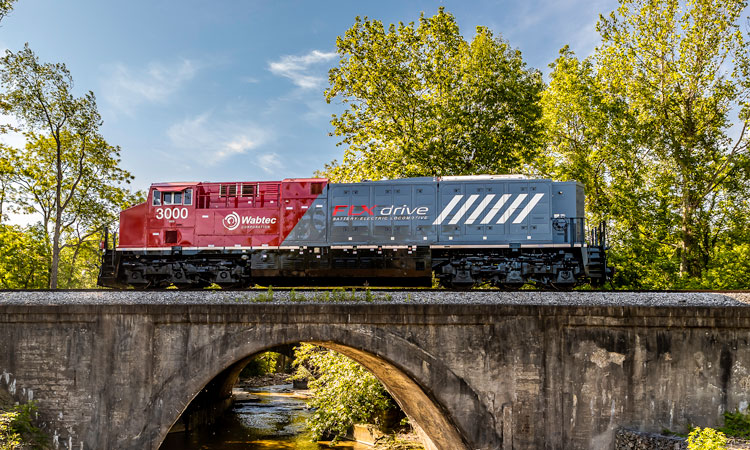Wabtec’s EdgeLINC™: Driving the next stage for connected trains
Posted: 8 June 2021 | Adebayo Onigbanjo, Intel, Wabtec Corporation | No comments yet
Adebayo Onigbanjo, Principal IoT Platforms and Application Leader for Wabtec Corporation’s Core Electronics and Data Analytics group, explains the next stage for connected trains and how rail operators can truly drive transformation.


To help level set, what do you consider as a connected train?
In its simplest form, a connected train is a train that is constantly visible and reporting its condition, status and location to a back office or remote system. While this is not new because machine-to-machine (m2m) systems have offered a variation of this, the difference today is this connectivity is enabled by the Internet. The Internet of Things (IoT) platform is a broader system that moves away from the monolithic architecture common to m2m systems to a more microservices architecture that truly enables true connectedness and collaboration.
So how is Wabtec enabling this connectivity?
Wabtec is proud to be one of the leading global providers of equipment and technical solutions for the rail industry. Over the past few years, we have combined forces with several prominent leaders in this space and we have a portfolio that supports both transit and freight customers. Together, we are propelling the rail industry forward with technical innovation, unique digital solutions, and world-class manufacturing and services. It is our intention to not only provide solutions that integrate, but also to promote cross collaboration and visibility.
As a company, we quickly identified the need for an IoT platform that helps bring these various components together and have remained focused on making the capability available to all our customers and partners. The EdgeLINC™ platform is one of the key lifecycle management platforms within Wabtec that is primed to enable true and agnostic connectivity on the train. The platform adopts a standard IoT framework that supports industry standard protocols and communication interfaces to enable a secured way to connect devices and ingest data from them into a cloud environment. Once there, it offers a front-end application programming interface (API) for rapid application development.
Why is this now so important?
Data continues to grow in importance across all sectors, largely because we are getting more capabilities and technologies that allow us to process the data and make more meaning from it, so the starting point is being able to retrieve the data from the source. Once this is achieved then it becomes a matter of understanding what use‑case you are trying to address. In the past, access to the data was limited. Today, all this is changing and truly enabling new capabilities. This can be thought of in the following three phases:
1. Sensing – the connectivity and collection of data
2. Analysing – the interpretation of data to provide a wider perspective
3. Action – trusting the technology to recommend an action based on the various data sets collected and analysed.
Railroads and train operators are committed to their operations and customers. By increasing the capabilities of the technology, they have a good opportunity to get the ‘actions’ and focus on executing them.
How does the Wabtec EdgeLINC™ solution help railroads?
As aforementioned, Wabtec’s EdgeLINC™ is an infrastructure that enables us to rapidly address challenges that our railroad and train operator partners face in their operation. One simple example is the Asset Tracking and Status Download Application (ATSD), which allows train operators to have one common dashboard to view all critical data parameters from the train, eliminating the need for operators to view multiple dashboards or systems to get a real‑time snapshot of the location, condition and status of the connected train.
Another example is our Dwell and Asset Utilisation application. For freight railroads, their efficiency is measured by how much they can move from point A to point B and how long it takes. However, like every planned event, a number of real world actions happen that are not planned. The Dwell and Asset Utilisation application focuses on measuring the actual dwell experienced by every freight train, such as the location of the delay, the duration and the economic impact of such a delay.
The bottom line? Decreased costs and competitive advantage through optimised routing, fewer service stops, and faster provisioning all contribute to higher utilisation, and more hours spent in revenue‑generating service.
So, what devices does the Wabtec software run on?
EdgeLINC™ offers a range of onboard software or agents that can run on compatible devices that act as a gateway or processor host for the software. Today, Wabtec has a range of onboard communication devices such as the GoLINC™ platform and its Train Management Computer (TMC)™ that can host the software. In addition to Wabtec devices, the software agent can be hosted on other Linux based platforms that meet the onboard and safety requirements of a railroad or train operator.
To learn more, please visit: wabteccorp.com/digital-electronics/ core‑electronics-and-analytics
WABTEC AND INTEL PARTERNSHIP
Wabtec is the world’s foremost rail technology company with over 150 years of experience across both the transportation and industrial sectors. Wabtec’s merger with GE Transportation (former business unit of GE) establishes the company as a Fortune 500, global transportation and logistics leader and a strategic Intel partner. Wabtec is an Intel Partner Alliance Gold member leveraging Intel products and technologies to enable Intel’s ecosystem customers across various segments such as rail, fleet, marine. For more information about the Intel Partner Alliance portal, please visit: www.intel.com/partneralliance


Issue
Related topics
Big Data, Digitalisation, Internet of Things (IoT), Technology & Software








